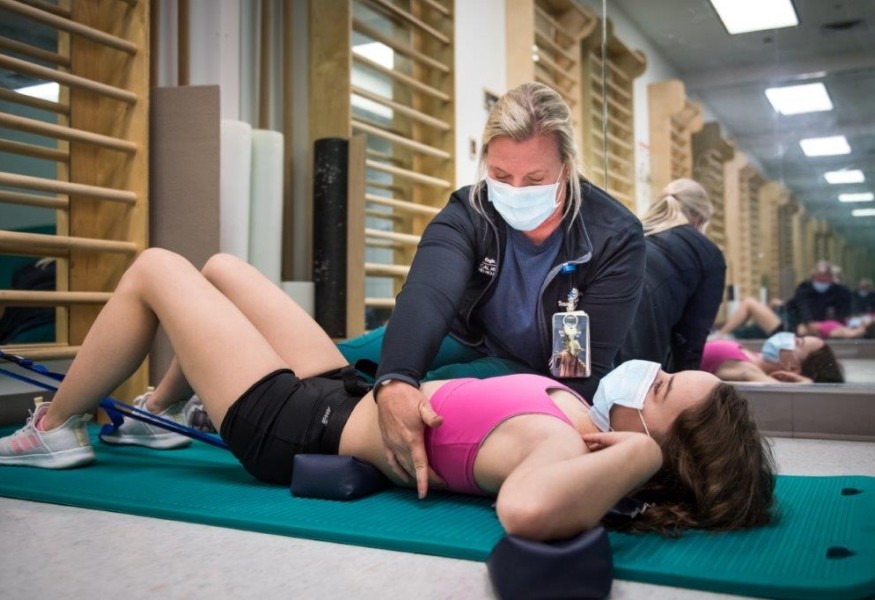Topics

Photo courtesy of Allen Kramer (Texas Children's Hospital)
As a physical therapist for the Schroth Therapy Program at Texas Children’s, I enjoy seeing my patients smile when they see the incredible progress they’ve made after a few therapy sessions with me. My goal as their physical therapist is to motivate, empower and encourage my patients. No matter how difficult their current circumstances may be, they can overcome any challenge with confidence.
For children and teenagers with scoliosis, physical appearance and positive body image mean everything to them. Depending on the severity of their scoliosis, a visibly curved or twisted spinal column can cause uneven shoulders, breathing difficulties, back pain and a humpback or swayback appearance. If left untreated, these conditions can get worse over time. In the most severe cases – when the curvature is greater than 50 degrees – surgery may be necessary to correct the deformity. When surgery is required, our pediatric spine specialists collaborate with neurosurgeons, pulmonologists and other specialists at Texas Children’s to coordinate care and create the best possible outcomes. But, for children with mild to moderate cases, the collaboration with the Scoliosis and Spinal Deformity Program allows for a multidisciplinary team which aims to treat scoliosis with a non-surgical approach first.
Collaborating with the Orthopedics team, I use Schroth-based physical therapy treatment to improve the posture of patients with scoliosis. This conservative approach uses thinking ability, muscle coordination, sensory skills and posture awareness to provide better support for the spine in patients with mild to severe curvatures. These exercises decrease the rotation and stretch in the trunk while increasing muscle strength. Ideally, we start Schroth-based exercises prior to puberty (usually age 10 for girls and 12 for boys) when their curvature and rotation is still mild and during the peak risk of spinal curve progression.
Most of my PT patients have mild to moderate scoliosis. Scoliosis severity is moderate when the Cobb angle (a measurement for spinal curvature) ranges from 20 to 40 degrees. When I first met my patient, Lucy Giele, in Nov. 2019, she had moderate idiopathic scoliosis. Her X-ray showed a 28-degree angle in her thoracic curve (middle of spine) and a 34-degree angle in her lumbar curve (bottom of spine). Prior to Schroth therapy, Lucy wore a back brace to keep her spinal curvature from progressing as she grew.
“When Lucy was 11-years old, she complained about back pain,” her mother, Agnes, said. “At first, I thought she pulled a muscle during cheerleading practice since she is very physically active. It wasn’t until she went in for an annual checkup that her doctor noticed a little bump on her back. When the bump didn’t go away, I took Lucy to an orthopedic specialist who recommended she wear a back brace to support her spine. Although she was very consistent with wearing it, her curvature was not getting better. When Lucy started seeing Dr. Brian Smith, he recommended she begin Schroth-based physical therapy with Sandra immediately. One month into Lucy’s PT, we saw immediate results. It was amazing!”
Beginning in Nov. 2019, Lucy came in for Schroth exercise sessions every week for almost a year. Since Schroth-based physical therapy is a 3-dimensional approach to a 3-dimensional problem, our first step was to correct Lucy’s pelvis in all planes of movement to create a neutral stable base to work with. After pelvic corrections, we incorporated auto-elongation using the Schroth bars and straps. Then, we used corrective breathing, muscle activation and de-rotational exercises to correct postural asymmetries. As she did these exercises, I helped her focus on how to breath and where to breath with verbal feedback and hand placement. I coached her to perform the exercises in a correct posture. By addressing these postural asymmetries early on, the amount of rotation and trunk imbalance decreased and her spinal curvature improved as well. Her follow-up X-ray looked much better than it did prior to Schroth.
In Feb. 2020, three months into her Schroth therapy, the angle of Lucy’s thoracic curve decreased from 28 to 20 degrees and her lumbar curve decreased from 34 to 27 degrees, which is a very significant improvement in a short period of time. Since then, Lucy, now 13, had a growth spurt and her angles increased five degrees each but they remain stable. The amount of rotation she demonstrates in her spine is very low. She has no trunk imbalance and her pelvis is in the position where it should be.
“Schroth therapy has been a life changer for me,” Lucy said. “Between my Schroth sessions with Sandra and practicing these exercises at home, I can tell my posture has improved. The Schroth exercises have taught me to be more aware of my posture. For instance, if I catch myself slouching or if my hips are not aligned properly, I know how to readjust my body to reduce my back pain. I also wear a customized brace that molds to my body to improve my posture. I usually wear it whenever I go to bed to rest my spine. I’ve learned so much from Sandra and I love Dr. Smith. He’s been wonderful to me. He has always included me in conversations with my mom about my care and treatment. As a patient, that means a lot to me.”
It’s wonderful to hear patients, like Lucy, make incredible progress. Most importantly, Lucy now has an improved body image and renewed self-confidence to manage her scoliosis in a more effective way. Seeing her smile reminds me how much I enjoy treating scoliosis patients using the Schroth technique.
Click here to learn more about our Scoliosis and Spinal Deformity Program. Click here to learn more about Schroth therapy and other non-surgical approaches to treat scoliosis and other spinal deformities.


